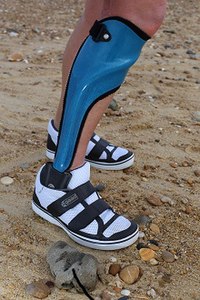
Photo from wikipedia
BACKGROUND Patients exhibit considerable variations in gait patterns especially in knee hyperextension in the stance phase after stroke. If knee hyperextension is untreated it may lead to pain, reduced independence… Click to show full abstract
BACKGROUND Patients exhibit considerable variations in gait patterns especially in knee hyperextension in the stance phase after stroke. If knee hyperextension is untreated it may lead to pain, reduced independence in activities of daily living, deformities and instability. OBJECTIVE The aim of this study was to investigate the immediate effects of a buffered knee orthosis on gait of stroke patients with knee hyperextension. METHODS A total of nine patients with knee hyperextension after stroke were selected to wear buffered knee orthosis developed by Zhongshan Traditional Chinese Medicine Hospital and Ruike Medical Technology (Shanghai) Co., Ltd during walking training and daily walking. Then the gait analysis system of Motionanalysis was used to analyze and evaluate kinematic and spatiotemporal parameters of the gait in patients with independent walking or walking with a buffered knee orthosis. RESULTS After wearing the buffered knee brace, initial contact, maximum and minimum angles of support phase, the toe off the ground, maximum and minimum angles of swing phase on the injured side of knee and ankle increased. Minimum angle of support phase and maximum angle of swing phase on the uninjured side of ankle decreased, while the toe off the ground and minimum angles of swing phase increased significantly (all P< 0.05); There was no significant difference in other kinematics, in parameters between time and space, in walking speed among subjective gait parameters (P> 0.05). Walking distance, confidence, sense of security, and the feeling of walking hyperextension were all improved. In addition, the number of asymmetric kinematic parameters and spatiotemporal parameters decreased. CONCLUSION The buffered knee orthosis can effectively prevent knee hyperextension after stroke, improve the knee and ankle sagittal motion, gait asymmetry, gait subjective feeling, and does not affect gait space-time parameters.
Journal Title: Journal of back and musculoskeletal rehabilitation
Year Published: 2022
Link to full text (if available)
Share on Social Media: Sign Up to like & get
recommendations!